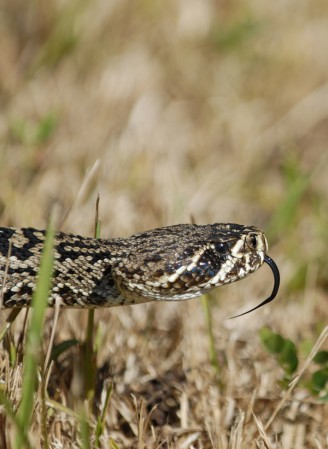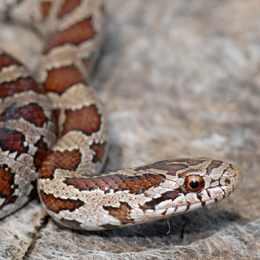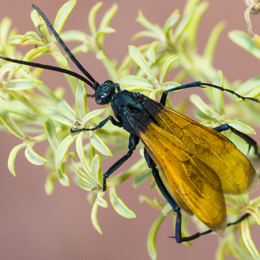Physical Description
The Eastern Diamondback gets its name from the intricate arrangement of the scales on its body that is aligned in various colors.
The color pattern is made up of brownish, brownish-yellow, brownish-gray or even olive ground scales which are overlaid with a number of dark brown to black shaped diamonds that has a slightly lighter centre. Each of these diamond-shaped markings is outlined with a row of light cream or yellow scales. The belly of the snake is yellowish or cream colored.
The tail of the snake is dark comprising of the rattle which is made of loosely attached, hard, hollow segments that make a rattling sound when shaken.
The infra-red, heat sensitive pit located between its eyes and nostril is a honing device which helps the snake to hunt down its prey in the dark.
It is a wrong assumption that one can determine the snake’s age through its rattle size since it sheds and forms new rattle segments after a month or few weeks.
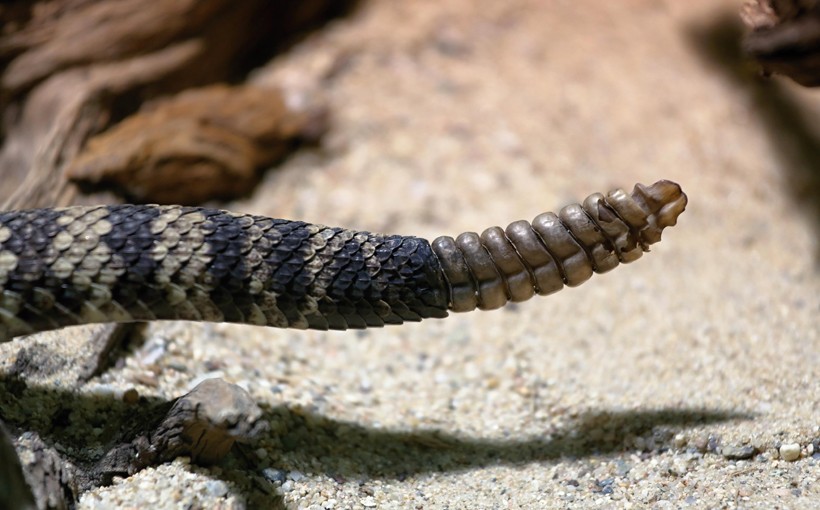
The hard hollow segments from which the rattle is made of creates the typical noise
?
Image credits: muuraa/Shutterstock
Size and Life Span
The average documented weight of Eastern Diamondback rattlesnake has been recorded between 2 to 3 kilograms (5 lbs) and has an average length between 1.0 - 1.7 meters (3.5 to 5.5 feet). Although, there have been reports of bigger and heavier specimens, these have not been accurately documented.
The male eastern diamondback is larger and heavier than the female although they look alike in terms of skin color. Baby rattlers have a tail that ends with a button at the tip which is the first segment of a future rattle.
The natural life span of this snake is between 10 to 15 years but studies in the field suggest that only a few of its kind can live for more than 10 years.
The venom of the eastern diamondback is a hemotoxin that destroys RBCs and leads to tissue damage. While adults release a certain quantity of venom in a bite, baby rattlers are more dangerous. This is because they can’t control the venom they inject which can easily lead to fatalities.
At the time of birth, baby rattlers are about 12-14 inches (0.3 meters) long.
Anatomy and Characteristics
The Eastern Diamondback rattlesnake is easily recognizable by its unmistakable markings on its back. The distinguishing dark diamond shaped patterns ringed by a lighter color makes it very easy to differentiate this snake from others of its species.
The eyes of the Eastern Diamond appear as dark beads on its head and act as receptors to movements in the surrounding. Its morphology makes the diamondback a potential killer, capable of raising its body up to 2/3 its original length and striking at a recorded speed of 175 mph (281.6 km/h).
The eastern diamondback rattlesnake has the longest fangs (1 inch) of the rattlesnake species. The fangs yield 400-450 mg venom on an average. Estimated dosage that can turn lethal for humans is around 100-150 mg.
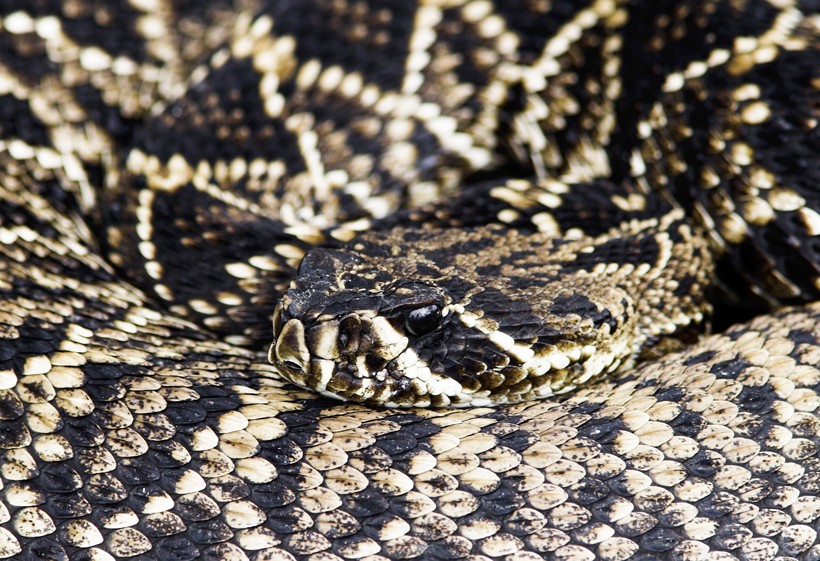
The Eastern Diamondback Rattlesnake is easy recognizable through the distinctive diamond pattern
?
Image credits: 8155069152/Shutterstock
Another distinguishing feature of the Eastern Diamondback rattlesnake is the presence of ‘pits’ on its head; one of the highly developed senses of the snake:
Pits: - The Eastern Diamondback, like all pit vipers, has two ‘pits’ located between its eyes. The ‘pits’ help the snake to sense heat that is radiated from a warm-blooded prey. Although, the range of the ‘pits’ is quite short but nevertheless, they give the Eastern Diamondback a distinct advantage in hunting, especially at night.
Eyes: - The eyes of the Eastern Diamondback are well adapted to both night as well as day giving them a sensory vision. Although there is no formation of sharp images, the snake relies more on movement which helps perceive the presence of its prey in the surroundings.
Smell: - This type of snake has an extremely well-developed sense of smell. This acute sense of perceiving smell is aided by its nostrils as well as by the use of its forked tongue. By flicking its forked tongue, the scent-bearing particles travel all the way to its sensory organ called ‘vomeronasal organ’ or Jacobson’s organ located at the roof of its mouth. Using this sensory organ the Eastern Diamondback can detect and discern its surroundings as well as its prey.
Ears: - The Eastern Diamondback, like all other rattlesnakes, do not have a well-developed sense of hearing since the structure of the middle ear is not as highly evolved as those of other vertebrates. But they make up for this lack of hearing by sensing vibrations on the ground.
A new study states that snakes can detect sound using vibrations or sound waves that affect the snake’s jaw bone and travels into the inner ear.
Habitat
The Eastern Diamondback rattlesnake is a heavyweight amongst the 32 recognized species of rattlesnakes and is terrestrial like most snakes.
It isn’t an avid climber, but some reports suggest that the snake has been seen on trees, probably in search of prey. This snake is often found in areas which offer large open tracts in canopy habitats. It is for this reason that the Eastern Diamondback rattlesnake is commonly found among pine flat woods and usually emerges out from its nest early morning or in the afternoon to bask in the sun.
Moreover, the intricate coloring and pattern on its back blend extremely well into the background which makes it almost impossible to be seen by its prey until the last, when it’s too late. Besides this, the snake also inhabits sand pine scrub areas and barrier islands lining the coastal areas. These areas are rich in palmetto thickets and burrows of the Gopher Tortoise where the diamondback often finds shelter.
The burrows of the Gopher Tortoise can be regarded as a form of commensalism which is a natural canopy for the snake to tunnel in and wait in ambush for its prey.
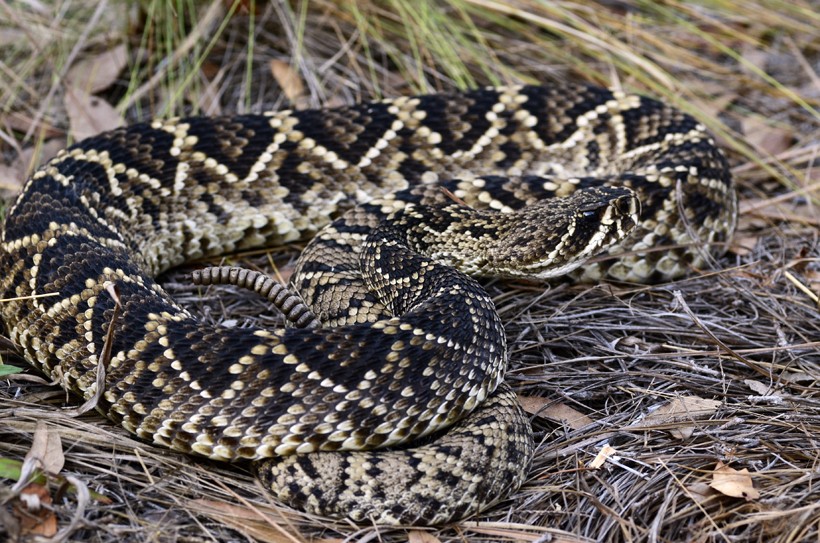
The snake is easily overlooked through the typical pattern
?
Image credits: Patrick K. Campbell/Shutterstock
The Hunter
The Eastern Diamondback rattlesnake is a fearsome hunter that uses two methods for hunting its prey. It will either actively go looking for its prey or lie in ambush, blending in perfectly with the background amongst fallen leaves and wait for an unsuspecting prey, like small mammals, especially rabbits and rodents to come within striking distance.
Most people believe the rattle is an indication of its territorial nature. However, this snake can hide behind thickets and stay motionless, striking unexpectedly at any creature that passes.
The eastern diamondback should be left alone due to its dangerous territorial nature. When an unsuspecting prey comes within striking distance, the diamondback lashes out, bites and releases its prey.
The potent venom, which is a hemotoxin, is released through its huge fangs into the body of its prey. This snake has an extremely fast strike which is recorded to being 175 miles per hour (281.6 km/h).
The snake then follows the scent of its dying prey and once found, swallows it whole to complete the process of feeding.
The Hunted
Although the Eastern Diamondback rattlesnake is a deadly and venomous snake, it’s not without its fair share of predators. It is preyed upon in the wild by the King Cobra, red-tailed hawks, eagles, great horned owls but perhaps the most ruthless of them all, humans.
This snake is killed indiscriminately for sport, commercial skin trading and by vehicle strikes. The latter becoming more significant because of habitat destruction that causes the snakes to wander off onto roads and highways in search for shelter.
Reproduction
The mating season of the diamondback is usually from late summer to early fall. Depending upon when the mating occurs, ovulation follows.
Usually with Eastern diamondbacks, the ovulation occurs in the later part of the spring of the following year. Eastern diamondbacks can store the sperm cells in their oviducts.
Once the mating process is over between a female and a particular male diamondback, the pregnant female moves into a sheltered den till she is ready to give birth to young ones.
The typical gestation period of a female diamondback is between six to seven months. A female rattler is viviparous. The eggs are basically membranous capsules retained inside the body of a female diamondback.
The mother regulates the temperature for the developing embryos by incubating the eggs inside her body. On average, 14 or even more (up to 32!) young ones are born in a secured nest underground after rupturing of the eggs.
The birth of young diamondbacks generally takes place in September, at the onset of fall. A female diamondback gives birth to anything up to two dozen young ones at a time.
Only 17 percent of the litter survives since young rattlers fall prey to a variety of predators. The young diamondbacks have all the characteristic markings of the adults save for the rattle, and are protected by the mother until their first shed which is around two weeks.
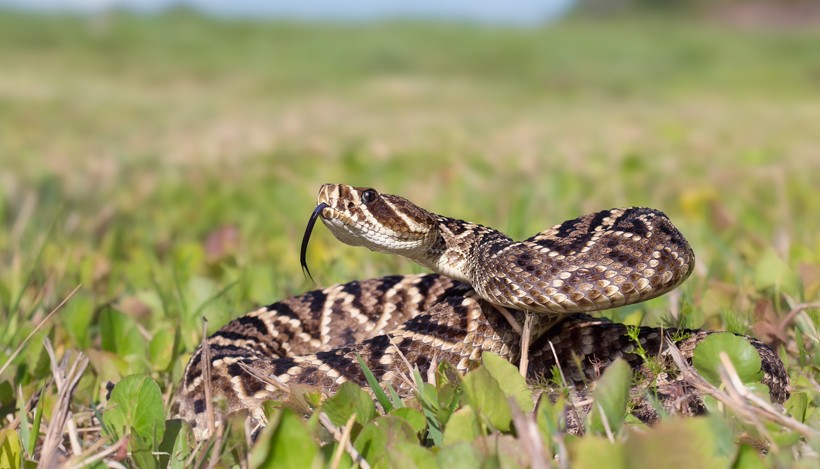
Diamondback heating up in the sun
?
Image credits: Kristian Bell/Shutterstock
Life Cycle
- In Nature – The natural life cycle of the Eastern Diamondback rattlesnake is around 10 to 15 years but certain field studies have revealed that only a few diamondbacks have survived longer than 10 years.
During this time-span, the female diamondback reaches sexual maturity anywhere between 2 to 6 years of age. After reaching this sexually productive stage, the female diamondback can reproduce only at intervals of two to four years. This depends on the geographical location of the habitat, its age and overall condition of the environment.
The young diamondbacks hardly stay with their mother for more than a few hours, before they go off on their own to find prey and take shelter. This accounts for a very high rate in the mortality of young diamondbacks.
- In Captivity – The Eastern Diamondbacks which are bred in captivity are in better circumstances than their natural counterparts. They can live beyond 20 years in the protective and conducive environment provided by conservationists.
The young born in captivity do quite well as they readily feed on the killed rodents, that are offered as food.
During this time-span, the female diamondback reaches sexual maturity anywhere between 2 to 6 years of age. After reaching this sexually productive stage, the female diamondback can reproduce only at intervals of two to four years. This depends on the geographical location of the habitat, its age and overall condition of the environment.
The young diamondbacks hardly stay with their mother for more than a few hours, before they go off on their own to find prey and take shelter. This accounts for a very high rate in the mortality of young diamondbacks.
The young born in captivity do quite well as they readily feed on the killed rodents, that are offered as food.
Hybrids
Though there have been no records of a natural hybridization of the eastern Diamondback with other species, in captivity certain experiments have taken place. A male Canebrake has been hybridized with an Eastern Diamondback by Roark Ferguson of Roark's Reptile Safari in 2006. Currently, the hybrid species is located at Chuck Hurd Serpentology.
Behavior
The Eastern Diamondback rattlesnake, like most other rattlesnakes, is a terrestrial species. The large and heavy body does not allow it to climb trees in search of its prey. But there are a few reports that suggest that this snake has been seen on trees at least about thirty feet above the ground. However, this is not a regular occurrence.
On the other hand, the diamondback is an excellent swimmer and has the ability to across salt marshes and freshwater wetlands.
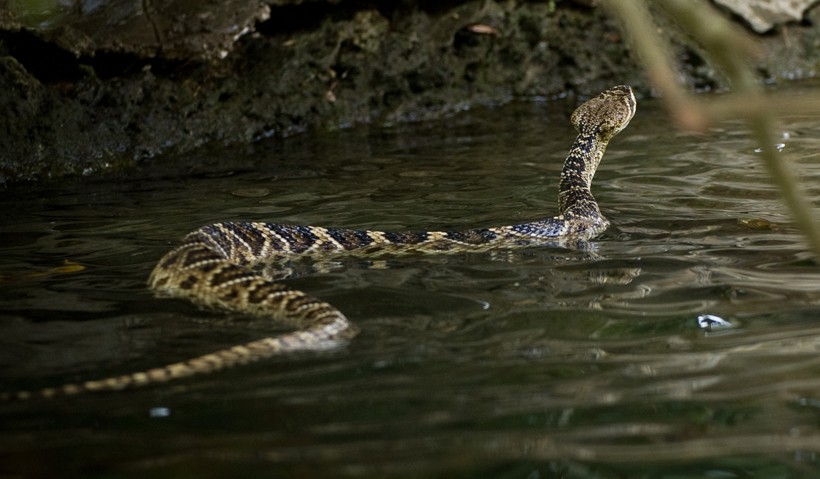
The diamondback is an excellent salt water swimmer
?
Image credits: Heiko Kiera/Shutterstock
Communication
Communication among diamondbacks is rare as they are solitary in nature. However they do possess the vomeronasal organ also called the Jacobson’s organ that consists of chemoreceptors and is part of the olfactory system in reptiles. This organ is mainly used to detect prey and predators but can also be used for chemical messages (readiness for sexual activity for example).
The diamondback like all snakes initiates a behavior called the ‘flehman response’ in which the snake flicks out its tongue to collect heavy moisture-born odor particles that stimulate the sensory cells. It is a vital organ that also picks up pheromones released by other diamondbacks to determine whether it is a female or male, the age and the reproductive state of the other.
The hiss and the rattle are used as communicating methods to ward off predators and also as a defense mechanism.
Being cold blooded, the diamondback must regulate its body temperature by using the warmth of the sun. To do this, it comes out of its den or the burrows of Gopher tortoise or even the hollows of rotting tree trunks to bask in the sun.
The snake is also known to be particularly active at dawn or late evening. Highly averse to humans, most snakes attack only when threatened.
The Eastern Diamondback rattlesnake does not always rattle before striking its prey or when it feels threatened. They can strike even without rattling their tails. This characteristic can vary between two diamondbacks. While a particular diamondback will allow close approach without rattling, another will start rattling even at distances of twenty to thirty feet. There are individual variances.
The diamondback snake is a solitary creature. There are no social bindings related to this species. It is only during the mating season that different males of this species show dominance and vie for the mating rights.
Males ‘fight’ with one another by raising the front portion of their bodies, entwining around one another in an intricate show of superiority and try to throw down the other.
Evolutionary History
The Eastern Diamondback rattlesnake’s lineage can be traced back to its ancestors that were an integral part of an ancient dry habitat fauna.
This ancient belt stretched from Florida to the southwestern United States. It has been postulated that this species probably had its origin in Mexico and the Southwest some 8 million years ago. It was from this region that the diamondback spread across throughout the continent of the United States, parts of Canada and Central and South America. In its present day habitat of the southeastern United States, fossil remains in Florida suggest that the diamondback had existed in the area for at least 2 million years.
Population, Threats & Conservation Status
Population
The adult population size of this species is not clearly known. But it is estimated that the population density of adult species are more than 100,000 in number, spread across suitable regions in the southeastern parts of the United States. Sadly only 2 to 3% of the species’ original habitat still exists.
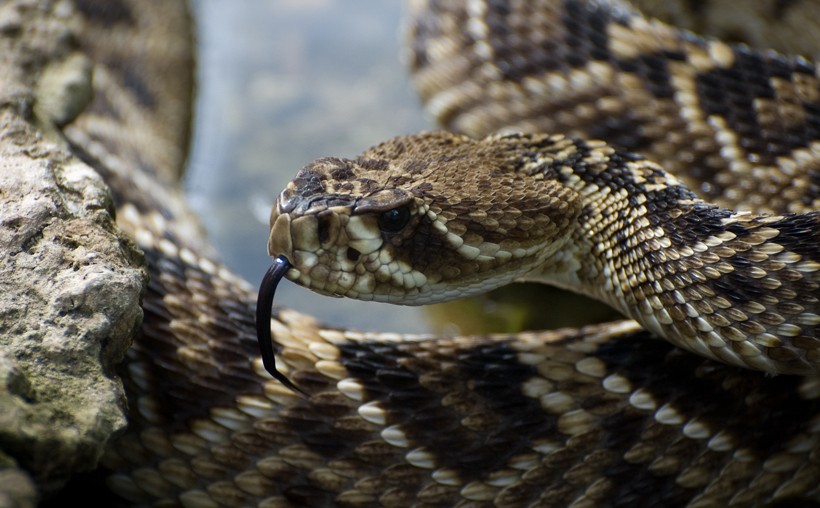
The population is decreasing constantly as result of loss of habitat
?
Image credits: Heiko Kiera/Shutterstock
Treats
The decreasing trend in the diamondback’s population can be attributed to the rampant killing of this species for its skin for commercial purposes and also the sharp decline of its natural habitat of longleaf pine forests. This is a major cause of concern threatening the existence of the diamondback due to severe fragmentation of its current habitat.
With the construction of roads and highways, development of townships and its protective natural cover being turned into agricultural lands, the diamondback comes more into contact with humans which results in the snake being killed by people or run over by automobiles.
Conservation Status
The Eastern Diamondback is classified as Least Concern on the IUCN (The International Union for Conservation of Nature) Red List. Although it figures as Least Concern because of its wide distribution, presumed large population and slow decrease in numbers, the trend in its population is witnessing a decline.
The Eastern Diamondback may be the next species to be listed as threatened by the laws that govern the ESA (Endangered Species Act).
In North Carolina, the Eastern Diamondback is considered to be endangered within the state and is protected by law. It has become extinct in the state of Louisiana having been last spotted in the mid nineteen nineties. But with the ever increasing destruction of its natural habitat, the Eastern Diamondback rattlesnake is being slowly but surely displaced from its original habitat. As a result of this displacement, the diamondback sometimes makes its way into parking lots, golf courses and even into people’s backyards.
Due to a habitat loss of 2-3% the Center for Biological Diversity filed a petition to add the Eastern Diamond Rattlesnake on the list of Endangered Species in August 2011. U.S. Fish and Wildlife Service reviewed the status in 2012 and announced that the Diamondback indeed may be a candidate to be placed on the endangered species list. In January 2013, Biological Diversity filed a notice of intent to sue U.S. Fish and Wildlife because they didn’t move forward.
At the moment (November 2015) the status is still ‘Under Review’. Biological Diversity expects that it will take still several years as the agency is facing a huge backlog of species that need final decisions.
The Orianne Society that attended the Southeast Partners for Amphibian and Reptile Conservation is playing a major role in conserving Eastern Diamondbacks by currently accessing the population and enabling conservation projects.
Funfacts
- The Eastern Diamondback Rattlesnake was used as the symbol for one the first flags of the United States called the Gadsden Flag and had the famous quote – “Don’t tread on me”.
- The Eastern Diamondback is a salt water swimmer and can bite underwater.
- The baby diamondback is as venomous as the adults but has no control over the release of its venom.
- The rattle of the baby diamondback does not rattle till it reaches a distinct age of maturity.
- Reports claim that the largest Eastern Diamondback yet recorded measure around 2.5 meters (8.25 feet).
